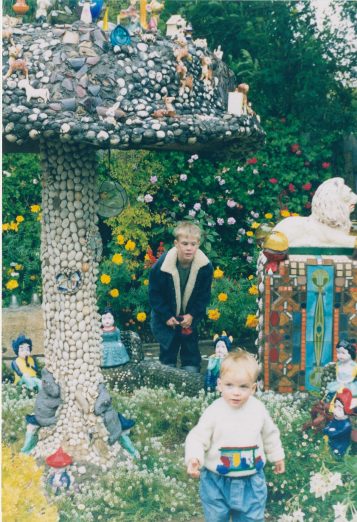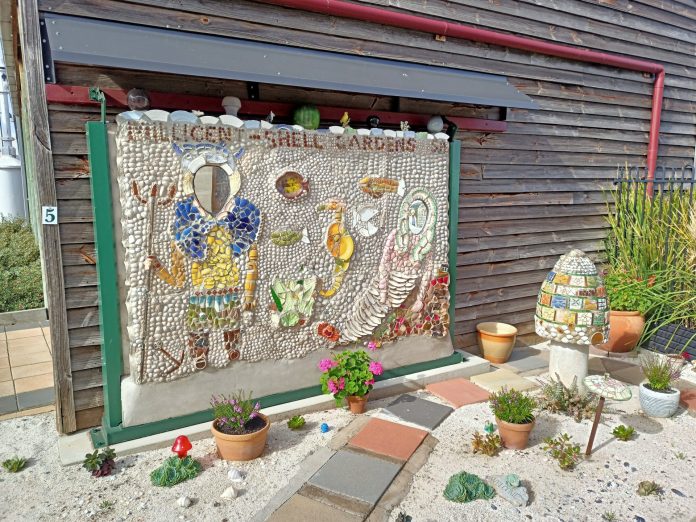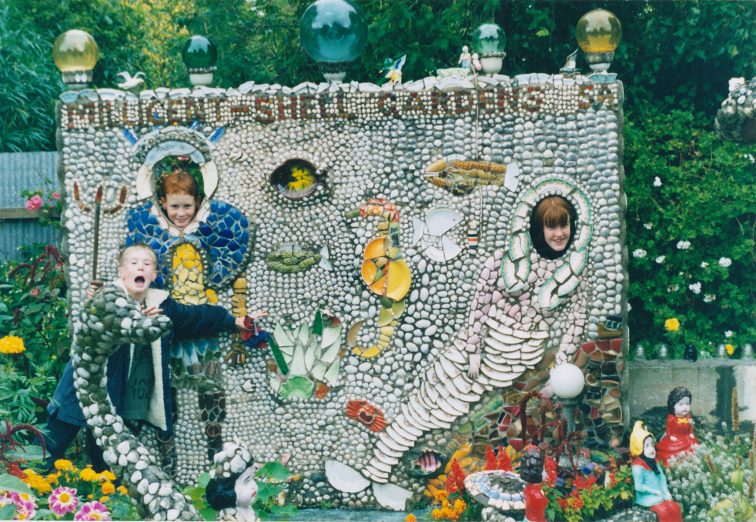A remarkable piece of Australian folk art history lives on thanks to a new permanent exhibit at the National Trust’s Millicent Museum. Flinders University student Madeleine Fewster shares the story that captured her imagination during a two-week placement as part of her creative writing degree.
In 1952, Mrs Iris Howe began to construct what would become one of Millicent’s most renowned tourist attractions. After transforming a pair of rubber boots with seashells and glass, Iris went on to cover much of her garden in decorative mosaics featuring a multitude of seashells set among shards of glass and crockery. With the support of her husband, Jack, she even created beautiful cement sculptures and mosaic scenes on the garden walls. Her work was surrounded by colourful foliage, bringing together the natural and the man-made in an artistic garden.
The Shell Gardens first opened to the general public in the 1960s. It quickly became popular with local children, and later with visitors from all over the country and even overseas. In 1972, Mrs Howe moved to Adelaide and the property was bought by Don and Aisla Salmon. The new owners continued to care for the garden and build its reputation as a tourist attraction.
Millicent’s Shell Gardens has been described as an excellent example of fantasy folk art. It blended elements of fairy tales and nursery rhymes with historical elements significant to the area. The appeal to children was part of what made it so successful. The walls and sculptures depicted characters such as Snow White and the Seven Dwarves, Humpty Dumpty and Dennis the Menace, as well as animals and ballerinas.
Other elements were even more significant because of their connection to local history and the people in Iris’s life. Her admiration for Millicent’s early pioneers was symbolised in an image of a loaded wagon, while her ancestors, who came to the area in the late 1800s, were depicted gathered around a campfire. Many of Iris’s friends and family were also illustrated, often in attire different to what they might have worn in daily life. For example, two of her friends were shown wearing circus outfits.
The Shell Gardens closed to the general public in 1998. Fourteen years later the property was sold to Boneham Aged Care Services and the house and gardens were demolished to make way for expanded facilities. But the tourism icon was not completely lost. Members of the Millicent branch of the National Trust were able to save some significant pieces, which are now on permanent display at the Millicent Museum.
They include the Mermaid Wall, one of the most recognisable elements, contributed by the Salmons. Tourists and locals alike would get their photo taken as they peered through holes in the wall, becoming either King Neptune or a mermaid. During transport to the museum, the wall sustained some damage and was broken into several pieces. However, volunteers worked passionately to repair it and fix it securely within a steel frame for display in an outdoor area, where it was placed in 2023.
Nearby is the pioneer wall created by Iris, which contains the quote: ‘When singing our praises of progress in years, try and remember the old pioneers’. Now restored, this piece in particular reveals much about her dedication to portraying the history of the town through her art. The new area also includes some of the smaller sculptures that were saved, complemented by succulents and flowering plants. A sign donated by Jim and Louise Hyland contains pictures of the original Shell Gardens and information about its history.
Although the original gardens’ closure was a great loss to the community, owing to the hard work of volunteers at the Millicent Museum, the new Shell Gardens now preserves an important chapter in Millicent’s history, reviving the treasured memories of the thousands of people across generations who enjoyed it.






